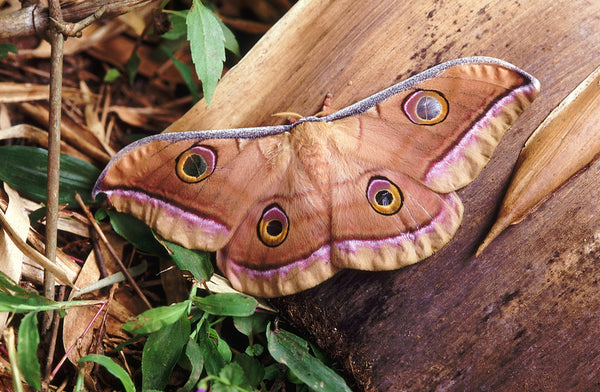Know Your Fiber: Tussah Silk
Posted on July 02 2021

Tussah, tussar, tusar, tasar, and more… so many names for just one type of silk! Produced in only a few countries, tussah silk is perhaps best known as a wild silk that is collected in the forests of India and other countries in South Asia. This golden-hued silk is different from cultivated silks – it is more textured and spins up into a yarn with a bit more loft to it. This loft provides exceptional breathability in warm weather as well as insulation in cooler weather, creating woven or knit fabrics that are comfortable to wear in nearly any season.
Bombyx mori, the domestic silk moth that is typically raised in warehouses, makes much of the silk we see in our clothing and in our luxury yarn blends. Cultivated silk is, of course, lovely and provides amazing sheen drape to any cloth it is in. However, there are over 500 different silk moth species moths in the world, busy creating different silks for adventurous fiber aficionados. Tussah moths are from the genus Antheraea, and the species that makes tussah silk feeds on leaves from oak and jamun trees, rather than the mulberry leaves that B. mori prefer. Oak and jamun leaves are rich in tannin, which is what helps give tussah silk its lustrous, golden hue.
Silk in India has a long history, and recent discoveries show that the practice of spinning silk from wild silkworms there may be nearly as old as sericulture – the cultivation of silkworms – in China. Remains of spun silk fibers have been found at archaeological sites of the Indus Civilization (c. 2800-1500 BCE). These fibers were found in bronze and chlorite beads dated to between about 2600-2200 BCE and provide proof that the craft of silk spinning was already well known in India during this period. Further research has shown that the silk in the beads was not from B. mori, the domesticated silkworm from China, but rather from A. assamensis – one of the tussah moths species, and native to South Asia.
Indian silk trade grew right alongside Chinese silk trade. By the time of the Gupta Empire (late-200 CE to 543 CE) India had become a major player, exporting silk and silk fabrics via the Indian Ocean throughout the Middle East, and onward to parts of Africa and the Mediterranean. Indian silk trade also played a role in helping to establish the Silk Road from China to Europe as a major trade route – traders would travel the Silk Road with silks from both China and India. However, as sericulture in China improved, cultivated silk soon overtook the wild silk trade, causing cultivated silk to be much more available in Europe than its wild cousins. Knowledge of tussah silk in the West faded. However, when Europeans began to colonize the Indian sub-continent in the 1600s, wild silks re-entered European consciousness. Treated as a curiosity at first, tussah silk products soon became quite popular. Europeans were particularly fond of quilts, pillows, curtains, and other household goods created or embroidered with tussah and other Indian silks. These were luxury goods, though, and not available to many people. The invention of “artificial silk” – aka viscose – in the late 1800s provided a cheaper substitute that more people could afford, and the silk market began to gradually decline. As it did so, interest in the wild silks of India also began to decline once again. It was not until the revival of artisan hand-spinning and weaving in the mid-1900s that tussah silk would once again find its place with crafters of the western hemisphere.
Today, tussah cocoons in India are still gathered by people of tribal villages in Bhagalpur, Bihar, and areas of West Bengal. While this rural industry faded for a time due to low commercial demand for tussah, it has seen a rebirth over the last few decades. Harvesting, processing, and weaving tussah silk was for generations done mostly by men. However, thanks to rural retraining programs in India, women are increasingly involved in tussah harvesting and processing. Weaving tussah silk, however, remains a largely male task. Much of the tussah silk from India goes into fabric for apparel and décor. Fiber artists in the western hemisphere have also embraced the use of tussah silk. As fiber artists, we enjoy spinning, knitting, crocheting, and weaving this wonderful fiber. Tussah silk is also beginning to find a home in other crafts – soap makers will sometimes use tussah silk in their soaps. It turns out that dissolving tussah silk in the lye produces a luxury soap with a lustrous look and a silky feel.
Most tussah silk top and yarns available in North America ranges between 21-26 microns, although both thicker and thinner tussah silk can sometimes be found. Like all silks, tussah has amazing sheen and luster. The staple length of tussah silk is shorter than that of cultivated silk, but at 4-6 inches long it is still plenty long for most spinners. Undyed tussah is a light golden color, and like all silks it has an amazing sheen and luster. Many spinners like to blend tussah silk with a fine or medium-fine wool to create a yarn with a wonderful feel and drape.
Make sure to visit us at our shop in Bellingham, WA or online at www.nwyarns.com to see what we have in stock!


Follow US